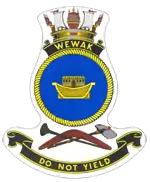 HMAS Wewak unloading or loading an Australian Army truck during Operation Bel Isi on Bougainville | |
| History | |
|---|---|
| Namesake | Wewak, Papua New Guinea |
| Builder | Walkers Limited in Maryborough, Queensland |
| Laid down | 21 March 1972 |
| Launched | 19 May 1972 |
| Commissioned | 10 August 1973 |
| Decommissioned | 11 December 2012 |
| Homeport | HMAS Cairns |
| Motto | "Do Not Yield" |
| Fate | Transferred to Philippine Navy. |
| Badge |  |
| Name | Iwak |
| Namesake | Iwak people, a minor Filipino ethnic group found in the Cordillera region in the island of Luzon, Philippines |
| Acquired | 2016 |
| Commissioned | 1 June 2016 |
| General characteristics | |
| Class and type | Balikpapan-class landing craft heavy |
| Displacement | 316 tons |
| Length | 44.5 m (146 ft) |
| Beam | 10.1 m (33 ft) |
| Propulsion | Two GM Detroit 12v71 diesels |
| Speed | 9 knots (17 km/h; 10 mph) |
| Capacity | 180 tons of vehicle cargo or 400 soldiers |
| Complement | 13 |
| Armament | two 0.50 inch machine guns |
HMAS Wewak (L 130) was the fifth ship of the Balikpapan class of heavy landing craft operated by the Royal Australian Navy (RAN).
Design and construction
The eight-vessel Balikpapan class was ordered as a locally manufactured replacement for the Australian Army's LSM-1-class landing ship medium and ALC 50 landing craft.[1] They are 44.5 metres (146 ft) long, with a beam of 10.1 metres (33 ft), and a draught of 1.9 metres (6 ft 3 in).[2] The landing craft have a standard displacement of 316 tons, with a full load displacement of 503 tons.[2] They are propelled by two G.M. Detroit 6-71 diesel motors, providing 675 brake horsepower to the two propeller shafts, allowing the vessels to reach 9 knots (17 km/h; 10 mph).[2] The standard ship's company is 13-strong.[2] The Balikpapans are equipped with a Decca RM 916 navigational radar, and fitted with two 7.62 millimetres (0.300 in) machine guns for self-defence.[2]
The LCHs have a maximum payload of 180 tons; equivalent to 3 Leopard 1 tanks, 13 M113 armoured personnel carriers 23 quarter-tonne trucks, or four LARC-V amphibious cargo vehicles.[2][3] As a troop transport, a Balikpapan-class vessel can transport up to 400 soldiers between a larger amphibious ship and the shore, or embark 60 soldiers in six-berth caravans for longer voyages.[3][4] The vessel's payload affects the range: at 175 tons of cargo, each vessel has a range of 1,300 nautical miles (2,400 km; 1,500 mi), which increases to 2,280 nautical miles (4,220 km; 2,620 mi) with a 150-ton payload, and 3,000 nautical miles (5,600 km; 3,500 mi) when unladen.[2] The flat, box-like keel causes the ships to roll considerably in other-than-calm conditions, limiting their ability to make long voyages.[3]
Wewak was laid down by Walkers Limited at Maryborough, Queensland on 21 March 1972, launched on 19 May 1972, and commissioned into the RAN on 10 August 1973.[5]
Operational history
Following the destruction of Darwin by Cyclone Tracy during the night of 24–25 December 1974, Wewak was deployed as part of the relief effort; Operation Navy Help Darwin.[6] Wewak was the last of the 13 ships to join the operation; sailing from Brisbane on 2 January 1975, and arriving on 13 January.[6]
Wewak was placed in reserve on 16 August 1985; one of three landing craft decommissioned for economic reasons.[3][7] She was reactivated in late 2000, but only after lengthy delays, as during the intervening years, she had been used as a parts hulk for the other Balikpapans.[7]
Decommissioning and Fate
Wewak was decommissioned on 11 December 2012.[8]
The Philippine Navy has shown interest in acquiring the ship, after the Australian government donated 2 other sisterships, HMAS Brunei and HMAS Tarakan in 2015.[9][10] It was later confirmed that the Philippine Navy is acquiring three more LCH from Australia, including ex-HMAS Wewak, at a token price.[11]
References
- ↑ Gillett, Australian and New Zealand Warships since 1946, pp. 79, 125
- 1 2 3 4 5 6 7 Wertheim (ed.), The Naval Institute Guide to Combat Fleets of the World, p. 26
- 1 2 3 4 Gillett, Australian and New Zealand Warships since 1946, p. 79
- ↑ "Balikpapan Class Heavy Landing Craft (LCH), Australia". Naval Technology. 2014. Retrieved 27 September 2014.
- ↑ Swinden, Heavy Lifting for Four Decades, p. 20
- 1 2 Swinden, Heavy Lifting for Four Decades, p. 22
- ↑ "HMAS Wewak decommissioned". Department of Defence. 11 December 2012. Retrieved 13 December 2012.
- ↑ "Australia to donate heavy landing craft to Philippines". IHS Jane's 360. 29 January 2015. Retrieved 4 November 2015.
- ↑ "Philippines edges closer to Australian landing craft procurement". IHS Jane's 360. 29 July 2015. Retrieved 4 November 2015.
- ↑ "Australia confirms Philippines' acquisition of three ex-RAN landing craft". IHS Jane's 360. 27 October 2015. Retrieved 4 November 2015.
Sources
Books
- Gillett, Ross (1988). Australian and New Zealand Warships since 1946. Brookvale, NSW: Child & Associates. ISBN 0-86777-219-0. OCLC 23470364.
- Wertheim, Eric, ed. (2007). The Naval Institute Guide to Combat Fleets of the World: Their Ships, Aircraft, and Systems (15th ed.). Annapolis, MD: Naval Institute Press. ISBN 978-1-59114-955-2. OCLC 140283156.
Journal articles
- "Disaster Relief — Cyclone Tracy and Tasman Bridge". Semaphore. Sea Power Centre. 2004 (14). December 2004. Archived from the original on 13 February 2009. Retrieved 18 December 2011.
- Swinden, Greg (April 2013). "Heavy Lifting for Four Decades: The Navy's Landing Craft Heavy". The Navy. Navy League of Australia. 75 (2): 20–24. ISSN 1322-6231.